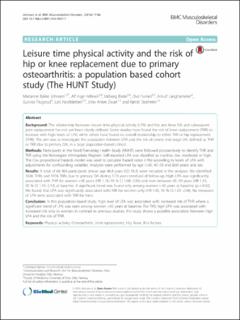| dc.contributor.author | Johnsen, Marianne Bakke | |
| dc.contributor.author | Hellevik, Alf Inge | |
| dc.contributor.author | Baste, Valborg | |
| dc.contributor.author | Furnes, Ove | |
| dc.contributor.author | Langhammer, Arnulf | |
| dc.contributor.author | Flugsrud, Gunnar B | |
| dc.contributor.author | Nordsletten, Lars | |
| dc.contributor.author | Zwart, John-Anker | |
| dc.contributor.author | Storheim, Kjersti | |
| dc.date.accessioned | 2020-04-01T14:13:43Z | |
| dc.date.available | 2020-04-01T14:13:43Z | |
| dc.date.created | 2016-03-07T14:29:21Z | |
| dc.date.issued | 2016 | |
| dc.identifier.citation | BMC Musculoskeletal Disorders. 2016, 17 (86), . | |
| dc.identifier.issn | 1471-2474 | |
| dc.identifier.uri | https://hdl.handle.net/11250/2649952 | |
| dc.description.abstract | Background The relationship between leisure time physical activity (LPA) and hip and knee OA and subsequent joint replacement has not yet been clearly defined. Some studies have found the risk of knee replacement (TKR) to increase with high levels of LPA, while others have found no overall relationship to either TKR or hip replacement (THR). The aim was to investigate the association between LPA and the risk of severe end-stage OA, defined as THR or TKR due to primary OA, in a large population-based cohort. Methods Participants in the Nord-Trøndelag Health Study (HUNT) were followed prospectively to identify THR and TKR using the Norwegian Arthroplasty Register. Self-reported LPA was classified as inactive, low, moderate or high. The Cox proportional hazards model was used to calculate hazard ratios (HRs) according to levels of LPA with adjustments for confounding variables. Analyses were performed by age (<45, 45–59 and ≥60 years) and sex. Results A total of 66 964 participants (mean age 46.8 years (SD 16.3) were included in the analyses. We identified 1636 THRs and 1016 TKRs due to primary OA during 17.0 years (median) of follow-up. High LPA was significantly associated with THR for women <45 years (HR 1.78, 95 % CI 1.08–2.94) and men between 45–59 years (HR 1.53, 95 % CI 1.10–2.13) at baseline. A significant trend was found only among women < 45 years at baseline (p = 0.02). We found that LPA was significantly associated with TKR for women only (HR 1.45, 95 % CI 1.03–2.04). No measures of LPA were associated with TKR for men. Conclusion In this population-based study, high level of LPA was associated with increased risk of THR where a significant trend of LPA was seen among women <45 years at baseline. For TKR, high LPA was associated with increased risk only in women. In contrast to previous studies, this study shows a possible association between high LPA and the risk of THR. | |
| dc.language.iso | eng | |
| dc.relation.uri | http://download.springer.com/static/pdf/87/art%253A10.1186%252Fs12891-016-0937-7.pdf?originUrl=http%3A%2F%2Fbmcmusculoskeletdisord.biomedcentral.com%2Farticle%2F10.1186%2Fs12891-016-0937-7&token2=exp= | |
| dc.title | Leisure time physical activity and the risk of hip or knee replacement due to primary osteoarthritis: A population based cohort study (The HUNT Study) | |
| dc.type | Peer reviewed | |
| dc.type | Journal article | |
| dc.description.version | publishedVersion | |
| cristin.ispublished | true | |
| cristin.fulltext | original | |
| cristin.qualitycode | 1 | |
| dc.identifier.doi | 10.1186/s12891-016-0937-7 | |
| dc.identifier.cristin | 1342713 | |
| dc.source.journal | BMC Musculoskeletal Disorders | |
| dc.source.volume | 17 | |
| dc.source.issue | 86 | |
| dc.source.pagenumber | 11 | |
